|
|
Welcome to my travel log! You will find here a lot more than in the travel reports, stripped from political correctness. Enjoy! 
Dec 29, 2005 07:00 PM Fajara - The Gambia, where the embassies are...
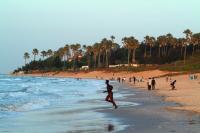 and the golf course.
and the golf course.
The town of Fajara, immediately west of Serekunda and by the coast, is actually hard to spot. No buildings can really be seen as they are hidden behind tall walls. I heard that Fajara was the top end town to have house in and the tall concrete walls are a good indication.
The few buildings which are visible from the streets are the bars, banks and restaurants, and one in particular - the 77. Actually I think the entire set of a bar, simple eatery and a booth selling fried chicken is called the 77. Although it is unsophisticated, it is not bad at all. It attracts both the locals and the tourists, who decided to stay in the town and not directly by the beach.
The beach of Fajara, which seamlessly becomes Kotu beach to the south, is where I met my new friends. It is a fine stretch of the coast, which offers some fine dining and drinking facilities, a night club (Galaxy), which I did not visit, and a curios market, which I did.
The ladies of the market, Aisha - for example, are keen to sell just anything to tourists. Aisha, having examined visually my linen shirt, wanted to strip me there and then and copy the shirt many times, using a fabric I was supposed to select myself. Mainly linen was in question, of course. All for a price of course. I did not let her.
Fajara and Kotu beach is full of tiny wooden juice booths. One or two guys work in the booths squeezing fresh fruit juices and making fruity milkshakes. There are so many of those booths, often two meters one from another, that it amazes me how they can ever produce any profit. The competition is fierce and the juices costing more than £1 are not the cheapest around, even for the ‘wealthy’ foreigners.
I asked the lads how the business was going and some of them had not sold a single glass for a few days. A good day for them is when they manage to sell three or four glasses.
It was actually fascinating for a European like me to watch how the guys managed the competition. As I found, not all the lads actually owned a juice pressing tool and had to share. Between five of them they had to share two manual juice pressing machines, and they were still complaining about the quality.
So, although they were all competing for customers, as soon as one of them has a customer, but not the machine, he needs to ask one of the other boys to lend him one. Actually, he does not even ask but takes it, makes the juice, and if he has time, he puts the tool back. Otherwise the owner has to find his own machine in case he happens to have a customer. It is rather special, is it not?
|
Dec 28, 2005 07:00 PM Serekunda - The Gambia, de-facto the capital
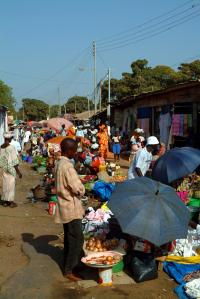 The traffic, the chaos, the dust, the crowds, the dirt, the heat and the noise are all what makes Serekunda. It is as bad as it really sounds.
The traffic, the chaos, the dust, the crowds, the dirt, the heat and the noise are all what makes Serekunda. It is as bad as it really sounds.
First of all, it is much easier to walk through the city rather than attempting to drive through it. The car congestion and the quality of potholed semi-dirt, semi-asphalt streets is the worst I have ever encountered in my life! And I am not joking!
I went through this terrible experience several times! I had instruct my driver that he must avoid the main roads in Serekunda and use some side lanes or something because I could not stand that traffic in the centre.
Serekunda is not nice. It grew to be the country’s centre of everything as Banjul could not grow due to natural and geographical constraints, being located on a island and surrounded by the Gambia river, the Atlantic Ocean, a lake and swamps.
The centre of the action oscillates around the main market, which to me is a giant labyrinth filled with everything that anyone might need to do anything and everything. Not the best quality, at all! I would even risk saying that of very poor quality indeed.
The market is vast. I do not even know how big it is. It looks like Serekunda is made exclusively of a market and countless shops. I went there, inside the main cluster of shops and stands, three times and spending a considerable amount of time, I only scratched the surface. Apart from me, I did not see another white person there. No-one at the market was selling anything to do with tourism, so I am dead certain to say that it is a local market for the locals to supply local goods for the local needs.
I originally thought that it was the only place to buy things in the town, but later I discovered petty shops, supermarkets and booths specialising primarily in electronics, household goods, music, videos and mobile phones.
Apart from being a typical bustling, dusty African city, there is nothing to Serekunda. There is nothing to see there and apart from the ‘ladies night’ at Jokor, there is nothing to do there, either.
So, I do not have much more to say about Serekunda.
|
Dec 28, 2005 07:00 PM Kartong - The Gambia, beaches of perfection
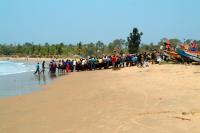 I managed to convince my driver to take me as far as Kartong, the last village before the southern border with Senegal. The beach there is awesomely fabulous. It is wide, empty and unspoiled - a perfect place for watching the sun go down and downing a cold sundowner.
I managed to convince my driver to take me as far as Kartong, the last village before the southern border with Senegal. The beach there is awesomely fabulous. It is wide, empty and unspoiled - a perfect place for watching the sun go down and downing a cold sundowner.
Unfortunately, I did not have a sundowner with me so I did not have the full experience I was imagining I could have, but the sunset was great and guys could not believe how grand the beach was. Although it was some forty kilometres from Serekunda, they had never been there.
I took my camera out and started shooting some pictures. The great advantage of digital photography is that the result can be immediately seen on a little LCD screen at the back of the camera. As soon as Ernest saw the quality of the pictures, he took his T-shirt off and asked for some pictures to be taken of him and the lights of the setting sun. I think the results were quite spectacular. He was very happy with the results.
When Solomon saw what I could do with my camera, and how good Ernest looked on the pictures, he declared to be the next in line for a photo session.
So, there I was on a great beach doing a job of a professional photographer. It was really funny, because although the lads had bodies of super models, they did not have the experience of posing. I had to shout direction at them as I were a professional photographer! It was hard work!
We must have been on the beach for about forty five minutes and I had to be very careful with the camera settings as the sun was disappearing behind a thin layer of clouds just as it was about to be setting behind the horizon. It was getting darker and darker with every shot I made. I did not want to disappoint any of the guys, who expected their photographs to come out as good as Ernest’s.
I have to say that I really enjoyed taking those pictures for them. First of all the pictures were coming out pretty good and the lads did not have many photographs taken of them at all, since taking and developing photographs is an expensive business in The Gambia. Ernest showed me some of his photographs and there was only a small bunch of them, and there are no tactful ways of describing their quality.
The guys do not have cameras and even if they had, developing films and getting prints would be beyond their budgets. Getting photographs is not something people would do as part of their routine, since it cost considerable amounts of money.
I thought that perhaps a simple digital camera might be a good idea for my friends, but I am not sure they would be able to get prints off the memory cards in their country. This could be even more expensive than the conventional photography.
I printed a good selection of the photographs and sent them to the lads and they were very happy. Particularly as they managed to get their friends, whom I did not photograph, a little jealous.
This keeps stinging my mind and stirring my imagination that I could potentially pick up photography as a way of living. The problem is however that I do not have an established name as a photographer, and I am not sure I am good enough to become dependent on the income photography might bring. It is nevertheless something I really enjoy doing.
|
Dec 27, 2005 07:00 PM Kanilai - The Gambia, Presidential village, Jola's capital
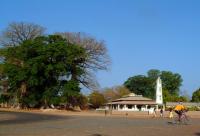 The village, where the president lives, Kanilai, enjoys a privilege to be a subject of many legends. The legends, most of which are totally baseless, speculate about the quality of life in the village.
The village, where the president lives, Kanilai, enjoys a privilege to be a subject of many legends. The legends, most of which are totally baseless, speculate about the quality of life in the village.
The Gambians, who never been to the Jola village of Kanilai would believe almost anything wonderful said about it. The reason for it is that the president, a Jola, came from the village and built his palace there. And people would believe the president poured unimaginable amounts of money to raise the living standard of his fellow villagers.
I almost believed it myself! I thought the village would boast magnificent buildings, a wonderful traditional wrestling stadium, clean streets, etc. So, I wanted to go and check it out.
I took one of my new friends there, who had never been to Kanilai.
The road from the coast to the village was very bad. Legend has it that the president has a secret motorway built from the airport to his village and that he does not let his bones rattle on the potholes. I believe this actually might be true.
It took almost forever to get there. ANd when I got there I saw the above presented picture. Absolutely nothing special. The houses were still poor and insignificant. The streets were not clean and the residents were dripping with wealth.
My driver and my friend were extremely disappointed! I could see the expression on their faces when we entered the village. They could not believe that the legends were not true!
They immediately promised themselves to tell the truth to everyone they knew how trivial Kanilai actually is. They could not wait to come back to the coast and tell everyone. At the same time they were happy that I brought them there. It felt good to learn about the true picture of the presidential village.
I could not even see the presidential palace because it is heavily guarded and hidden behind a tall wall. Almost adjacent to the most important residence in the entire country is a decent if a little overpriced lodge. It is set within a pleasant garden, has a pool and a fantastic restaurant. I think that the people visiting the president might be coming there for a meal.
I would not be happy to stay in the lodge though. There is absolutely nothing to do in Kanilai, it is actually in the middle of nowhere and what would I be doing there in the evenings? The thought itself scares me immensely.
|
Dec 26, 2005 07:00 PM Georgetown - The Gambia, a hole with nothing to do
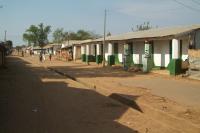 In the morning, I double convinced myself in my belief that the former capital of The Gambia was a hole with nothing to see and do. It was almost one street town with crumbling single-story houses, typical for British Africa. A few old warehouses from the colonial towns were so badly ruined it was impossible to recognise them as buildings.
In the morning, I double convinced myself in my belief that the former capital of The Gambia was a hole with nothing to see and do. It was almost one street town with crumbling single-story houses, typical for British Africa. A few old warehouses from the colonial towns were so badly ruined it was impossible to recognise them as buildings.
Fortunately, there was a shop there with a big fridge full of canned drinks. We re-stocked for the journey all the way back to the Atlantic Coast and went along the southern bank of the Gambia river.
|
Dec 25, 2005 07:00 PM Georgetown - The Gambia, an island for birdwatchers
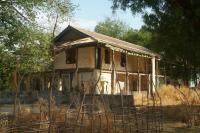 When I organised an escapade to Georgetown (now known as Jangjangbureh) and took more friends with me, I found how little the locals know about their country. They do not travel around much and rarely know any facts.
When I organised an escapade to Georgetown (now known as Jangjangbureh) and took more friends with me, I found how little the locals know about their country. They do not travel around much and rarely know any facts.
I insisted on travelling north of the river and returning to the coast on the track south of the river. I read about the ferries crossing the Gambia river in Georgetown and the boys did not believe me. They wanted to go back the same way. This was something I did not want to agree because, as I mentioned before, crossing the mouth of the river from Barra to Banjul is a major task, involving jumping the queue. I had to argue with them that the ferries did exist.
The road north of the river varied from excellent to extremely bad - a tricky sand track. The distance I was to make was just under 300 kilometres, but it seriously felt like it was by 1,300 kilometres longer. I just could not see the end of it. When I was first planning the journey, during my second visit to the country, I thought it should be possible to make the trip - there and back - in one day! I could not possibly be more wrong! It actually takes a day each way, and pushing it!
Georgetown was not the most important point in my itinerary. I was just travelling in its direction to see the mysterious stone circles and since the town was Gambia’s capital city, I was hoping to stop there for the night. Many locals claimed that it was an attractive town as well, with many great colonial buildings.
The wonderful picture of the former capital was also flawed and based on unfounded legends rather than facts. I did not see anything even remotely attractive in Jangjangbureh, apart from the river. What I saw was a few sandy streets lined up with extremely simple structures, which looked like warehouses rather than households.
I was content that I went there and saw it for myself. So were my friends. They were so happy that they actually thanked with a big hug. We did stay in a very nice lodge, packed with white travellers, serving buffet dinners and breakfasts (the guys could not believe they could eat as much as they wanted or could!) and boasting a swimming pool.
The swimming pool was a little sensation for the lads too. I do not think any of them had actually swam in a swimming pool, and I do believe that they might not even had ever taken a bath in a real bathtub. So, in the morning they decided to take a dip in the pool as part of their morning exercise routine. I did not even finish taking my shower and the guys were back from the pool saying the water was too cold.
I would not enter the pool for another reason. It did not look like it was being cleaned regularly and there were too many leaves and insects in the water for me.
Well, it was almost funny to see the lads’ disappointed faces. They stood in front of my hut, all wet, explaining how cold the water was. They still loved the lodge, though.
The place is called Bird Safari Camp and it does attracts bird watchers. The owners hired a few skilled and knowledgeable guides, who take the watchers to the jungle hoping to spot the many bird species living in the Gambia river valley.
I found a few books suggesting that it would be fine to linger around sluggish Georgetown for a few days. I would not recommend that at all. Unless one is a hardcore bird watcher, there is absolutely nothing to do and see in the immediate area. The only points of interest are the stone circles, which are a considerable distance away from the town.
|
Dec 25, 2005 07:00 PM Wassu Stones - The Gambia, UNESCO site
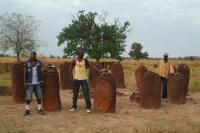 I knew about the stone circles called Wassu. I was not planning to see anything else. Yet, my strategy to take my local friends with me paid off! It turned out that Mustapha’s family came from the area and he took me to, what I would argue was, a much nicer stone circles.
I knew about the stone circles called Wassu. I was not planning to see anything else. Yet, my strategy to take my local friends with me paid off! It turned out that Mustapha’s family came from the area and he took me to, what I would argue was, a much nicer stone circles.
The Wassu stones found their way to one of the dalasi banknotes, and are by far the most visited stone circles in the country. There is very little known of the stones. Anyone who claims that knows their origin lies. There are only theories and speculations that the circles might be burial sites, yet there is no evidence to suggest it.
Now, if the stone circles were burial sites, they would be worshipped to the point that climbing on them and lingering by them, scratching them, etc. would be most definitely a taboo. Yet, kids and foreigners are allowed to do almost whatever they like around these mysterious monuments.
The stone circles await their inscription as the UNESCO World Heritage Site. And I think they deserve the status.
When I was there, walking among them, I felt an inexplicable energy, or a mystery surrounding the stones. I simply could not leave them. The keepers of the museums set up at the sites, insisted that I went in and saw the exhibitions they had set up, but I just wanted to linger around the circles.
Maybe that was because I knew what the museum were going to show me - unsophisticated expositions and vague speculations what the stones might be representing or had represented in the past. And I was not interested in checking out fairy-tales that someone had revelations to present in a museum. If it comes to museums in remote and exotic places, I am a facts man, and I do not suffer fantasising the history gladly.
I did go in and saw what the museum showed. I was pleased that the exhibits were mainly focusing on everyday life of the Gambians at the present day and dedicated in fact little room to speculation about the stone circles.
I was actually quite cheeky and I specifically asked the custodian of the museum where the stones come from and why they were there. To my greatest satisfaction the man said that he did not know and that no-one knew. I shook his hand! He enjoyed that very much.
Then, I was back with the stones, touching them, smelling them, feeling them, absorbing the mystery. I am not sure how to describe my fascination with the circles. As soon as I reached them, I forgot about the long hours on the bad road and no scenery around.
|
Dec 25, 2005 07:00 PM Kerrbatch Stones - The Gambia, UNESCO site
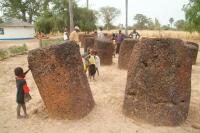 The mythical stone circles in The Gambia and Senegal, were always a spot I wanted to see. So, I organised a trip to go as far as Georgetown, and on the way to stop at the stone circles. Three of my friends insisted to join me, Ernest, Mustapha and Solomon. Mustapha new where the stones were. His family lived near.
The mythical stone circles in The Gambia and Senegal, were always a spot I wanted to see. So, I organised a trip to go as far as Georgetown, and on the way to stop at the stone circles. Three of my friends insisted to join me, Ernest, Mustapha and Solomon. Mustapha new where the stones were. His family lived near.
The first stone circles I saw, were those to which Mustapha took me - the Kerrabatch (pictured below). I liked them even more than the famous Wassu. They were smaller but thicker and there were slightly less in numbers. Their location was also much nicer, among a forest rather than in an open field.
I kept taking dozens of photographs at both locations, and as I did that, brats in numbers comparable to the number of the stones kept leaping in front of my lens. I did not mind taking a few pictures of them with the stones, and when I wanted to take the stones without them, Ernest, Mustapha and Solomon were doing a great job by clearing my aperture.
Whereas the Wassu stone circles are situated near the main road, the Kerrabatch ones are seriously hard to find. There are no signs directing to them and I had to turn off the main road and go via many small bush lanes and through small villages. I was amazed that Mustapha knew and remembered the way! Even my driver had doubts about the tracks we were driving on.
When I got there, the place, which was fenced off, was locked. Fortunately the keeper appeared promptly and opened up. And he appeared to be much happier to see me that I was to see him. I could imagine that he did not see many visitors there!
|
Dec 24, 2005 07:00 PM Sanyang - The Gambia, for the sunset
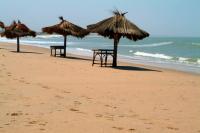 Two of my friends and I went to the Sanyang beach, near the border with Casamance. The lads wanted to take some pictures, featuring them and the sunset. A few young guys played football on the wider stretch of the beach.
Two of my friends and I went to the Sanyang beach, near the border with Casamance. The lads wanted to take some pictures, featuring them and the sunset. A few young guys played football on the wider stretch of the beach.
If one was looking for an air-conditioned bar with comfortable chairs then Senegambia and a handful of places around the Kotu beach are there to explore. However, if one was looking for a spot on a white sand by a bunch of smoking barbecues and monster speakers blasting local disco music, then the somewhat off-the-beaten-track and isolated southern beaches would be perfect for it.
As I was checking one beach after another, I stumbled upon a beach party like that at the Sanyang beach. I could not estimate the number of people partying there but the scene was fabulously animated.
It was shortly after the sunset. Many people were still taking a swim in the ocean. Some guys were running and training on the shore. A few chilled in a local, primitive bar sipping cold beers. And then there were those who grilled meats and fish on the mobile barbecue stands, making incredibly thick and smelly smoke.
The monster speakers positioned riskily on the sand kept blasting my favourite track of this trip - Brenda’s Vuli Ndlela. The music was so loud that it made the coconuts shake on the palm trees.
A dozen of local girls had managed to get in a trance boogieing and jumping to the rhythm, adding a little dust to the smelly smoke.
It was obvious that everyone had a great time there. It was a hell of a party! I wished I had been able to stay longer with the crowd and party like them! When I was still at the High School, I was organising bonfire beach parties like that. They always ended interestingly. I was curious how that Sanyan party was going to end.
A little north of the party spot there was a fishing stretch of the beach ‘decorated’ with colourful fishing boats. It was a little fishy there yet still clean and safe to take a dip in the ocean.
During the day, that stretch of the beach offers a completely different sort of animation. The fishermen are busy mending their nets and cleaning their vessels. Their wives and daughters take care of the catch of the day.
Often the fishing beach doubles as a fish market and then the place becomes noisy and all sorts of animation take place.
|
Dec 24, 2005 07:00 PM Senegambia - The Gambia, for lunch & drink
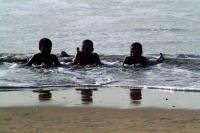 Near the only traffic light in the country, there is an area called Senegambia. It is the best, according to the locals, place to party. I had a great time there, I have to admit, but there are other, more atmospheric and authentic places to have a good time in the country. Even in the vicinity of Senegambia.
Near the only traffic light in the country, there is an area called Senegambia. It is the best, according to the locals, place to party. I had a great time there, I have to admit, but there are other, more atmospheric and authentic places to have a good time in the country. Even in the vicinity of Senegambia.
When I say the vicinity, I am not sure what I mean exactly, because The Gambia’s coast is rather short, so nowhere is very far, as long as one stays along the coast.
Anyway, Senegambia has a few nice places to eat. There are a nice Chinese and Lebanese restaurants, expensive African and Dutch-African options, as well as places with fusion cuisine. We had a pizza next to the African Queen restaurant.
|
Page:
 73 74 75 76 77 78 79 80 81 82 83
73 74 75 76 77 78 79 80 81 82 83

|
|
|
